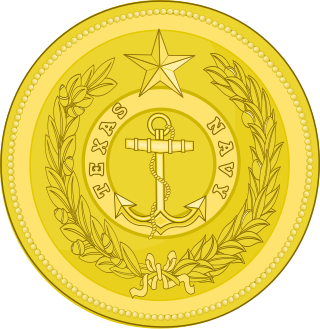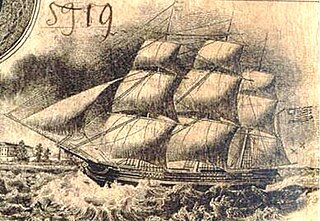
The Republic of Texas was a sovereign state in North America that existed from March 2, 1836, to February 19, 1846. It shared borders with Mexico, the Republic of the Rio Grande, and the United States of America.

Edwin Ward Moore, was an American naval officer who also served as commander-in-chief of the Navy of the Republic of Texas.
The "Battle of Tampico" was fought November 15, 1835, in the Mexican state of Tamaulipas. Gregorio Gómez and the Mexican Centralist garrison engaged Gen. José Antonio Mexía and 150 American volunteers. This was part of an uprising against General Santa Anna, and its outcome affected the future of the Texas War of Independence.

The Texas Navy, officially the Navy of the Republic of Texas, also known as the Second Texas Navy, was the naval warfare branch of the Texas Military Forces during the Republic of Texas. It descended from the Texian Navy, which was established in November 1835 to fight for independence from Centralist Republic of Mexico in the Texas Revolution. The Texas Navy, Texas Army, and Texas Militia were officially established on September 5, 1836 in Article II of the Constitution of the Republic of Texas. The Texas Navy and Texas Army were merged with the United States Armed Forces on February 19, 1846 after the Republic of Texas became the 28th state of the United States.

The Texan schooner Brutus was one of the four ships of the First Texas Navy (1836–1838) that during the Texas Revolution wreaked havoc on towns along the coast of Mexico, blockaded Mexican ports, and captured ships bound for Mexico with goods and munitions of war.
The Texas schooner Invincible was one of the four schooners of the Revolutionary Texas Navy (1836-1837). She began her service in January 1836 and immediately began attacking ships supplying the Mexican army in Texas, including capturing the United States merchant vessel Pocket and later the British ship Eliza Russell. Both of these actions caused diplomatic incidents between the Republic of Texas and the United States and the United Kingdom.

The Texas schooner Liberty was one of the four schooners of the First Texas Navy (1836–1838). She served in the Texas Navy for only about 6 months, capturing the Mexican brig Pelicano loaded with weapons for their army in Texas. Later that year, she sailed to New Orleans accompanying the wounded Sam Houston, where she was repaired. Texas was unable to pay for the repairs and the ship was sold in June, 1836, to pay for the cost of the repairs. This left the Texas Navy with only three ships.
The Texan schooner Independence was one of the four schooners of the First Texas Navy (1836–1838). At the direction of Texas Governor Henry Smith, in 1836 Charles Hawkins took command of United States revenue cutter Ingham acquired by the Texas Navy and renamed Independence.

The Texan brig Wharton was a two-masted brig of the Second Texas Navy from 1839-1846. She was the sister ship of the Archer. Accompanying the Texas flagship, Austin, she defeated a larger force of Mexican Navy steamships in the Naval Battle of Campeche in May 1843. Transferred to the United States Navy in 1846, she was sold for $55.

The Texan steamship Zavala was a Texas Navy ship in Texas' second Navy after the Texas Revolution. She was the first steamship-of-war in the Texas Navy.

The Texan sloop-of-war Austin was the flagship of the Second Texas Navy from 1840 to 1846. Commanded by Commodore Edwin Ward Moore, she led a flotilla in the capture of Villahermosa in 1840. After a period of inaction in port, Austin participated in the Naval Battle of Campeche in 1843. Austin was transferred to the United States Navy when Texas joined the United States in 1845, but was run aground and broken up in 1848.

The Naval Battle of Campeche took place on April 30, 1843, and May 16, 1843. The battle featured the most advanced warships of its day, including the Mexican steamer Guadalupe and the equally formidable Montezuma which engaged a squadron of vessels from the Second Republic of Yucatán and the Republic of Texas. The latter force consisted of the Texas Navy flagship sloop-of-war Austin, commanded by Commodore Edwin Ward Moore, the brig Wharton, and several schooners and five gunboats from the Republic of Yucatán, commanded by former Texas Navy Captain James D. Boylan.

USS Antona was a steamer captured by the Union Navy during the American Civil War. She was used by the Union Navy as a dispatch boat and gunboat in support of the Union Navy blockade of the Confederate States of America.

The Texan schooner San Jacinto was a two-masted schooner of the Second Texas Navy from 1839 to 1840. She was the sister ship of the San Antonio and the San Bernard. In 1840, San Jacinto was part of the Texas Navy flotilla led by Commodore Edwin Ward Moore which was dispatched to assist Yucatecan rebels that had taken up arms against Mexico. In a storm, San Jacinto ran aground at Cayos Arcas and was wrecked. The crew were rescued by the flagship Austin.

The Texan schooner San Antonio was a two-masted schooner of the Second Texas Navy from 1839-1840. She was the sister ship of the San Jacinto and the San Bernard. In 1840, San Antonio was part of the Texas Navy flotilla led by Commodore Edwin Ward Moore which was dispatched to assist Yucatecan rebels that had taken up arms against Mexico. In February 1842, while re-provisioning in New Orleans, the crew of the San Antonio mutinied and the Lieutenant was killed. This was the only mutiny in the history of the Texas Navy. That fall, the San Antonio sailed for Campeche and was never heard from again.

The Texan schooner San Bernard was a two-masted schooner of the Second Texas Navy from 1839-1840. She was the sister ship of the San Jacinto and the San Antonio. In 1840, San Antonio was part of the Texas Navy flotilla led by Commodore Edwin Ward Moore which was dispatched to assist Yucatecan rebels that had taken up arms against Mexico. Returning to the Yucatan in 1841, San Bernard assisted in the capture of three Mexican prizes. Upon return to Galveston, San Bernard was driven ashore and was not repaired. When Texas joined the United States in 1846, San Bernard was transferred to the United States Navy and then sold for $150.

Spanish attempts to reconquer Mexico were efforts by the Spanish government to regain possession of its former colony of New Spain, resulting in episodes of war comprised in clashes between the newly born Mexican nation and Spain. The designation mainly covers two periods: the first attempts occurred from 1821 to 1825 and involved the defense of Mexico's territorial waters, while the second period had two stages, including the Mexican expansion plan to take the Spanish-held island of Cuba between 1826 and 1828 and the 1829 expedition of Spanish General Isidro Barradas, which landed on Mexican soil with the object of reconquering Mexican territory. Although the Spanish never regained control of the country, they damaged the fledgling Mexican economy.

The Texian Navy, also known as the Revolutionary Navy and First Texas Navy, was the naval warfare branch of the Texian armed forces during the Texas Revolution. It was established by the Consultation of the Republic of Texas on November 25, 1835. Along with the Texian Army, it helped the Republic of Texas win independence from the Centralist Republic of Mexico on May 14, 1836 at the Treaties of Velasco. It was replaced by the Texas Navy on March 23, 1839.

The Texan brig Potomac was a ship of the Second Texas Navy that never sailed as a warship. For a while, in 1838, she was the only ship in the Texas Navy. She was decommissioned in 1843.

John Melville Allen was a soldier and the first Mayor of Galveston.











